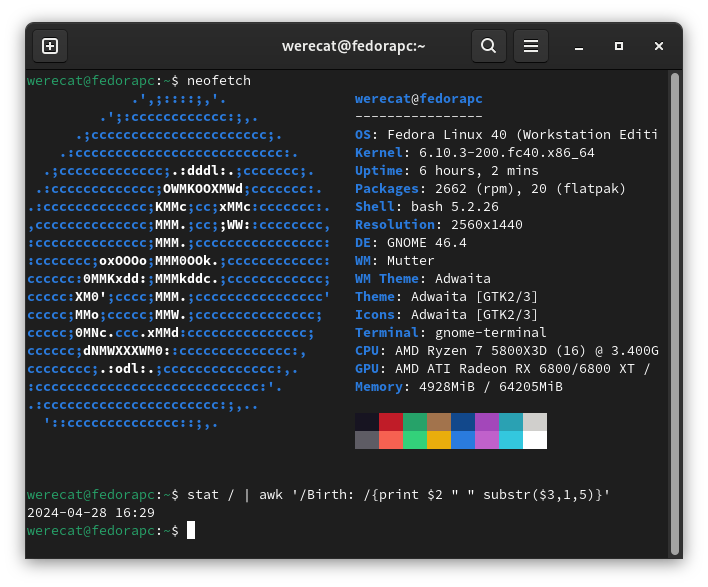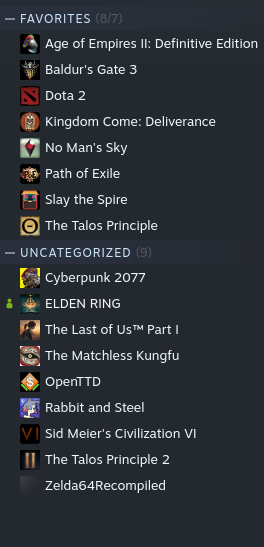I’ve tried to switch multiple times and always found or encountered some issue that got me back to Windows (on desktop PC).
Last year it was after 2 months on Fedora 38 KDE when I had enough with the KDE Window Manager acting weird and broken unusable VRR on desktop and some other smaller but daily issues that I went back to W11 on my PC.
I like GNOME over KDE and back then there was no VRR support on GNOME so I only had to stick with KDE, now it’s a different story.

I still have some minor annoyance which are probably solvable but I don’t know how as I didn’t put enough effort in finding solution.
Namely:
1.) Sometimes my 2nd monitor after boot remains blank and I have to unplug and plug back in the DP cable from the graphics card. Typically happens after a kernel update or restart but rarely on cold boot. I’ve seen others having this issue on Fedora40 but I haven’t seen any solution mentioned.
2.) Steam UI hangs up sometimes for several seconds when trying to navigate fast trough it and especially if it needs to pop a different window.
3.) GPU VRAM OC is completely busted and even doing ±1MHz will result in massive artifacting even on desktop, not a big deal but I would take the extra 5% boost I can have from VRAM OC on Windows :)
4.) After every Kernel update I have to run two commands to get my GPU overclock to work again. I haven’t figured out yet how to make a scrip that can read output from 1st command and copy it into 2nd command so I just do it manually every time which is roughly once a week.
5.) Free scrolling does not work in Chromium based browsers :( Luckily Vivaldi has some nice workaround with mouse gestures but I would still like free scrolling like on Windows.
And these are about the only annoyance I found worthwhile to mention.
Gaming works fine.

The apps I use typically work fine on Linux as well. Mangohud is amazing. No issues with audio unlike my last experience. Heck even Discord has no issues streaming video and audio now despite just using the web app. VRR despite being experimental works flawlessly on GNOME for me. I’m happy.


1.) IDK, this issue tends to manifest for me with different distros as well sometimes. Forgot to mention that it also happens if monitors go to sleep when inactive and on wake up the 2nd screen sometimes does not wake. That’s why I disabled sleep for monitors.
2.) So far works fine after disabling HW acceleration
4.) no need to waste both of ours time. The script now works fine but thanks for offer. I don’t even know what half of your sentence means :D
3.) On Windows I use MPT to further modify the cards behaviour like SOC voltages, clock, FCLK clock, TDC limits and power limits, etc… Basically I can easily squeeze 10% on top of the typical overclocking available via MSI Afterburner or AMD Adrenaline SW. #73rd place in TimeSpy for GPU score which is kinda ridiculous for air cooled card
https://www.3dmark.com/search#advanced?test=spy P&cpuId=&gpuId=1348&gpuCount=1&gpuType=ALL&deviceType=ALL&storageModel=ALL&showRamDisks=false&memoryChannels=0&country=&scoreType=graphicsScore&hofMode=true&showInvalidResults=false&freeParams=&minGpuCoreClock=&maxGpuCoreClock=&minGpuMemClock=&maxGpuMemClock=&minCpuClock=&maxCpuClock=
Cyberpunk likes to draw a lot of current so my tweaks help alleviate the throttling caused by it in typical OC scenarios as the card hits current limit in the CP2077 benchmark more often than it hits the actual power limit. That’s why the lows on Linux are worse, it’s not related to CPU underperforming. I’d suspect that the lows would be actually better if I could uncap GPU TDC current limit on Linux. Averages would be likely still lower vs Windows due to lack of VRAM OC.
This is not really comparable and I would have to do proper test on both Windows and Linux with the same versions of the game but I’ve tested with the same settings which are FOV = 100, SSR = Low (because it performs like crap on higher settings for no visual benefit), everything else maxed out.
This is screenshot from the run I did in February with my Windows OC… (also had worse CPU and memory tune back then vs what I run now so results would be slightly better now as well).
And this is from right now on Fedora 40… not sure why CP detects it as Windows 10
Would be interesting to keep the same game versions and GPU,CPU,DRAM tune and do a direct comparison but I can’t really be bothered right now to mess with that. What’s important to me that it’s roughly in the same ballpark and there are no massive swings in performance so unless I keep a close eye on monitoring I can hardly tell a difference when playing.
I see. I’m really not keen on the use of MPT since I’ve seen it fairly broadly recommended to more casual users (I’d place the blame on certain YouTubers), occasionally leading to bricked ASICs, though I’m glad you’re seeing tangible benefit from using it.
Please bear in mind that custom tuning isn’t a guarantee between different driver versions; the voltage floor can shift with power management firmware changes delivered driver packages (this doesn’t overwrite the board VBIOS, it’s loaded in at OS runtime (pmfw is also included in linux-firmware)). I’d recommend testing with vulkan memory test with each Adrenalin update, and every now and then on Fedora too.
I’m aware. For now it seems to behave consistently. I observed higher avg clocks on Linux vs Windows with the same OC but then again it may be due to difference in monitoring SW or just polling rate.